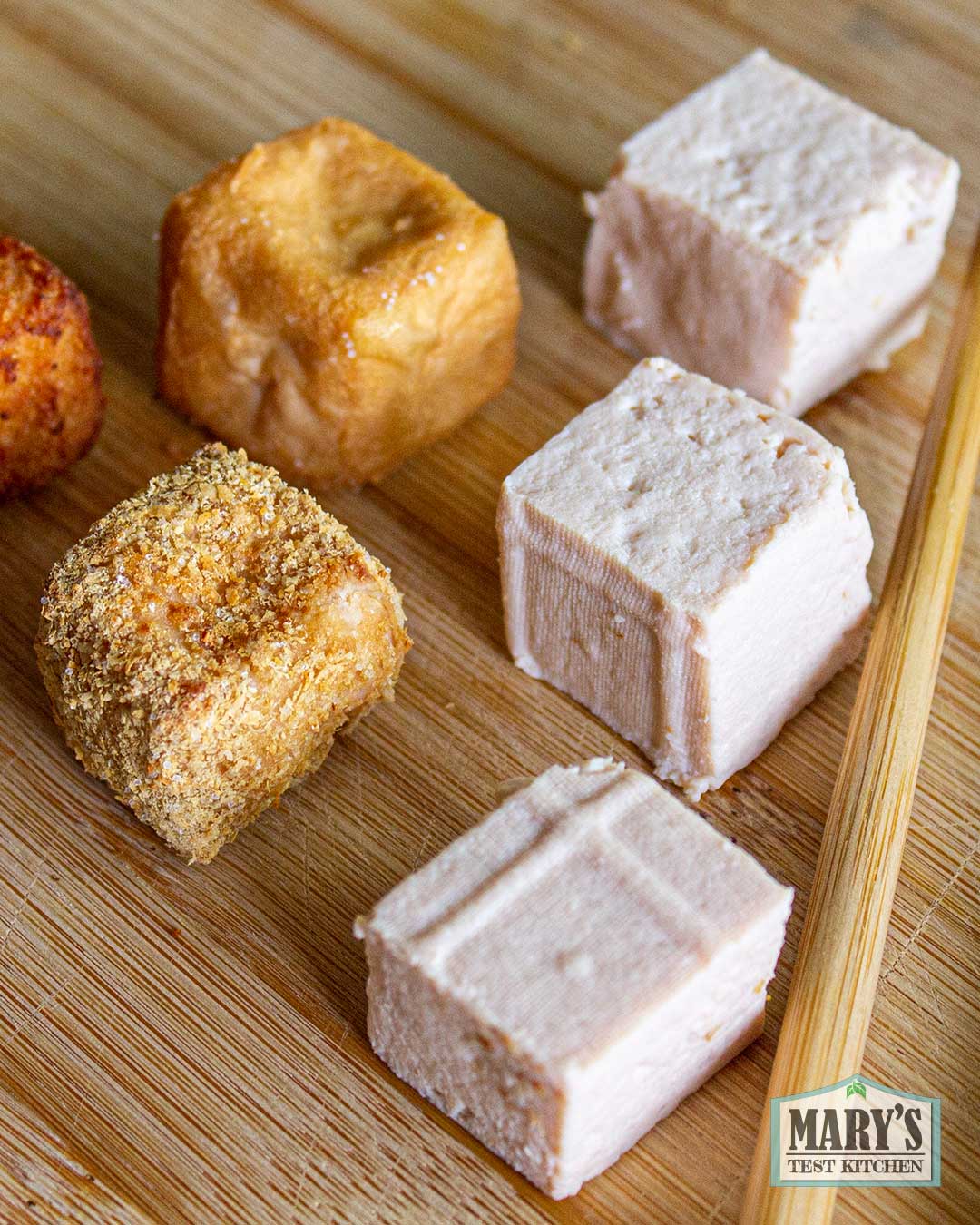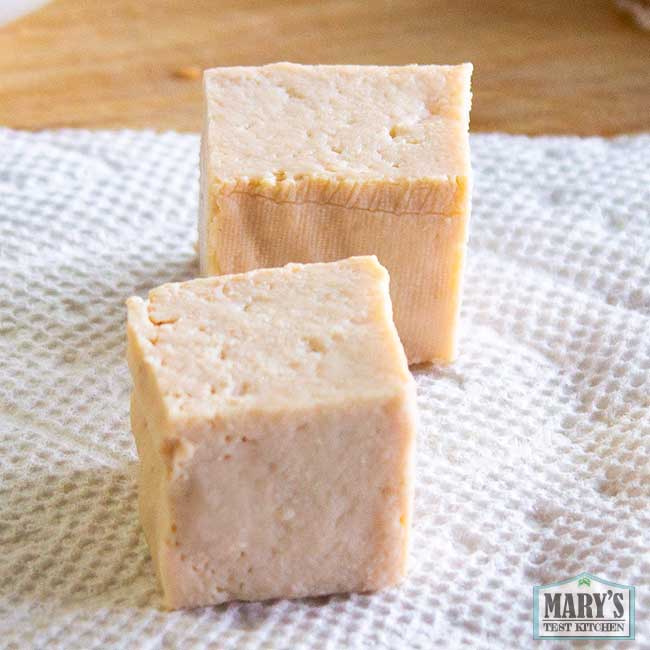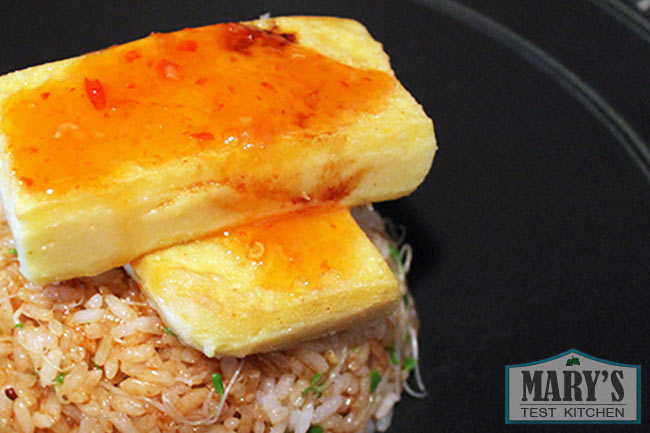This is PINK TOFU! High protein, soy-free, lower carb red lentil tofu that’s not like other red lentil tofu recipes. The others are made like Burmese Tofu (aka Shan Tofu or Chickpea Tofu) where the whole bean or legume is used. In this recipe, the fiber and starch is removed, leaving you tofu that is mainly protein. It’s delicious, creamy, and beautiful tofu!
Video Tutorial for Pink Tofu (High Protein Red Lentil Tofu)
More Tofu From Scratch
If you’re looking for more Soy-Free Tofu, check out
If you’re looking for how to make Soy Tofu, check out
Why High-Protein Red Lentil Tofu
Since refining my recipe for soy-free fava bean tofu, I am on a mission to see what other plant-based foods I can turn into high-protein, low carb tofu. Red lentils were my first choice after fava beans because they are super accessible, inexpensive and high in protein relative to other plant-based sources.

I haven’t seen anyone make red lentil tofu like this before so I’m taking the liberty of naming it: Pink Tofu! It’s a creamy delicate tofu that is absolutely divine seasoned and air-fried or deep fried.
Why make Soy-Free Tofu from Red Lentils?
If you are allergic to soy and can’t have fava beans (which make tofu that’s almost identical to soy tofu), this is a great high-protein alternative! Personally, I love to eat soy but I also love to have variety when it comes to plant-based protein sources.
I also absolutely loved red lentil or I have for years. But recently I have not been able to eat them because they are too high in carbs for my personal health condition. I was afraid my giant jar of red lentils was going to go bad in my pantry. But after the success of my new fava bean tofu recipe, I had to give red lentil tofu a try.
Why you’ll love Pink Tofu
This red lentil tofu is different from all the other red lentil tofu recipes I could find on YouTube or through Google search. Those are all basically using whole lentils or lentil flour, blending with water and cooking the mixture until it gels up like Burmese Tofu (aka Shan Tofu or Chickpea Tofu). The starch and fiber are contained. While I love fiber as much as any other gut-having foodie, I could do without the starch.
Pink Tofu is made like more traditional tofu. That is, the fiber is removed and the protein milk is coagulated into curds, then pressed into a block. Because lentils are high in starch, I have inserted an extra step to let the starch settle so it can be separated. The result is high protein red lentil tofu with much less carbohydrate content.

Written Recipe for Pink Tofu (High Protein Red Lentil Tofu)
PINK TOFU (High Protein Red Lentil Tofu)

A delicious, delicate and creamy soy-free tofu that's high protein and lower in carbohydrates from other red lentil tofu recipes.
Equipment required: blender, soy milk/ nut milk bag, tofu mold/press with cloth liner, large pot, spatula, and thermometer. with cloth liner
Ingredients
- 1 lb dried split red lentils (450g)
- 1 tbsp calcium sulfate (food grade gypsum)
- 1 cup room temperature water
Instructions
- Soak split red lentils in plenty of water for 10 to 15 minutes until plump. Rinse and drain very well. Then, transfer HALF to your blender along with 3 to 4 cups of fresh water. Blend in high-speed blender on high for 30 seconds. Over a large bowl or pot (prefer glass bowl to see through), strain through soy/nut milk bag until pulp is very dry. Repeat with other half of lentils.
- Let the milk rest for 15 minutes or longer to allow the starch to settle to the bottom of the bowl or pot. Then, use a cup to gently scoop only the milk to large cooking pot while avoiding disturbing the starchy layer below. You will have to leave some of the milk behind as it won't be possible to get it all without starch contamination.
- Let it warm up over medium low heat while you prepare your coagulant. Mix room temperature water with 1 tbsp calcium sulfate and keep it nearby with a spoon ready.
- Turn heat up to medium high or high but stir constantly so that the milk does not burn to the bottom. When in doubt, lower the heat. Keep cooking until the milk reaches 180°F then turn off the heat. Immediately, stir up your coagulant again. Pick it up in one hand, keep stirring the milk and pour in HALF the coagulant slowly. Stand the spatula straight down to stop the spinning action. Cover and rest for 15 minutes.
- Afterwards, check on how it coagulated. The whey should be clear if completely curdled. The curds will be distinct but soft and delicate. If it is completely curdled, save the rest of your coagulant for another day. If not, spoon the remaining coagulant over the top surface and around the sides. Tap the top gently to move the curds softly. Then cover again and turn the heat to the lowest setting. Wait 10 minutes and re-check. All the milk should be coagulated.
- Moisten the cloth and line your tofu mold. With a slotted spoon and/or mesh sieve, scoop the curds into the mold while holding the edges of the cloth so it doesn't fall in. The curds are very fine so you will have to tap against the side of the pot to drain more water. Try not to add too much water to the mold or it will be difficult to wrap. Try to spread the curds in evenly. Then add the top and secure. If using my preferred tofu mold, just twist the knob until it stops; do not force it. Pour off excess water using the vents. Please in fridge to cool overnight. If using weights, use about 5 lbs of weight, pour off excess water and place in fridge. The next day, gently unmold and your high protein, soy-free red lentil tofu is ready to use!
Notes
This soy-free tofu is creamy and delicate. Cut and handle with care like you would a soft or silken tofu.




So, I got the feeling that I could make any tofu from any bean following the tutorials you have been sharing. I have these purple spotted beans that I wanted to use up, the did not make tofu. I made a not-tofu abomination 🙈
awww I feel your pain, Arwen. I tried to use black turtle beans last week. It was a slimy disaster!
-Mary
I found you can use a piece of CLEAN airline tubing to siphon off the top liquid instead of having to spoon it off 🙂
Thanks for sharing, Nicole!
What is airline tubing?
Hi Mary!
Love your creativity! Just one quick question, how do I prevent the “bean-y” taste of the lentil tofu? I don’t like the strong flavor of the tofu. Is there any way to change it or make it milder so it can soak up the sauce of different recipes? Thanks!!
I didn’t feel the lentil tofu HAD a strong taste. Perhaps make sure to cook the lentil milk for 10 minutes at a steady simmer to make sure it’s totally cooked through before coagulating it.
Is there a way to know how to make tofu using this method without a thermometer? I am a broke college student with IBS and I am going to try to turn a number of my dried beans into tofu since I can’t eat them whole right now :(.
It’s not precise or the best practice I would recommend, but in general, if you bring the milk to a boil, that should be around 190-200°F. So just turn off the heat and very quickly add your coagulant and you should be in the right temperature range.
Thank you very much
I made this recipe. I tried to make the chick pea tofu but it was not good – I hadn’t waited long enough for the starch to settle out of the milk. This time I waited for the separation and had a lot of good starch and also “okara”.I brought the milk to temp and added the coagulant – but the curds were sooo fine – as I sieved them into my cheescloth there was a lot of water with them. when I closed the tofu press and tipped it to release the extra water – I lost all the curd. They were too small to be trapped in my cheescloth and went all down the drain. Glad I still had half a pot of milk (less than the amount that was lost – most of it was lost). I poured that back into the nut milk bag and put THAT into the tofu press. I’ll let y’all know tomorrow how that worked out.
I’m so curious how your red lentil tofu went, Donna!
For the chickpea tofu, I found that just bringing the chickpea milk to a boil was enough to coagulate it (no coagulant necessary). But I have not tried leaving in the starch to see how that affects things.
So sorry your chickpea tofu with coagulant did not work out.
I’ll have to try making it without removing starch and see if that is the factor that is prevent coagulation. Thanks for sharing your experience.
Cheers,
Mary
I’m making this at the moment and I’m wondering what people did with the pulp?
I have beeen determined to make your tofu recipes but something is going wrong each time! I’m on batch 7 with no bouncy tofu yet. Right now my red lentil mix has been sitting for about 30 minutes and I am seeing three layers: starch at the bottom, a big creamy pink layer, and a clear layer. Do I skim off everything but the white starch layer?
Batch 7 of red lentil tofu?! You’re my hero! That persistence in the face of adversity!!
To answer your question, yes, if your milk has settled into three layers, only skim off the starch layer.
This happened to me when I tried green pea tofu. I let the milk sit for much longer and I got the three layers as well. I actually coagulated the two layers in separate batches. You can see what happened in this video: https://www.youtube.com/watch?v=0ewWGU6hfhw
Hope that helps!!
Well, batch seven of the different types (chickpea, red lentil, and fava bean). 😊 I’ve had success finally!! Thank you for these awesome guides. I like to avoid soy as much as possible and thanks to you I have some awesome options!
WOHOO! Congratulations! Your perseverance paid off <3
How much lemon juice could I use in this recipe instead of the calcium?
In general, I use 1 1/2 tablespoons of lemon juice diluted into 1/2 cup room temperature water for a batch of tofu using 1 lb of dried ingredient.
Hope that helps 🙂
-Mary
Do you know what the carb/fiber would be?